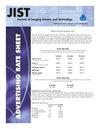Registration and Fusion of UAV LiDAR System Sequence Images and Laser Point Clouds
IF 0.5
4区 计算机科学
Q4 IMAGING SCIENCE & PHOTOGRAPHIC TECHNOLOGY
Journal of Imaging Science and Technology
Pub Date : 2021-01-01
DOI:10.2352/j.imagingsci.technol.2021.65.1.01050110.2352/j.imagingsci.technol.2021.65.1.010501
引用次数: 5
Abstract
Abstract The unmanned aerial vehicle (UAV)-mounted mobile LiDAR system (ULS) is widely used for geomatics owing to its efficient data acquisition and convenient operation. However, due to limited carrying capacity of a UAV, sensors integrated in the ULS should be small and lightweight, which results in decrease in the density of the collected scanning points. This affects registration between image data and point cloud data. To address this issue, the authors propose a method for registering and fusing ULS sequence images and laser point clouds, wherein they convert the problem of registering point cloud data and image data into a problem of matching feature points between the two images. First, a point cloud is selected to produce an intensity image. Subsequently, the corresponding feature points of the intensity image and the optical image are matched, and exterior orientation parameters are solved using a collinear equation based on image position and orientation. Finally, the sequence images are fused with the laser point cloud, based on the Global Navigation Satellite System (GNSS) time index of the optical image, to generate a true color point cloud. The experimental results show the higher registration accuracy and fusion speed of the proposed method, thereby demonstrating its accuracy and effectiveness.无人机激光雷达系统序列图像与激光点云的配准与融合
摘要无人机车载移动激光雷达系统(ULS)以其高效的数据采集和方便的操作,在地学领域得到了广泛的应用。然而,由于无人机的承载能力有限,集成在ULS中的传感器应该更小、更轻,这会导致收集的扫描点密度降低。这会影响图像数据和点云数据之间的配准。为了解决这个问题,作者提出了一种用于配准和融合ULS序列图像和激光点云的方法,其中他们将配准点云数据和图像数据的问题转化为两个图像之间的特征点匹配问题。首先,选择一个点云来生成强度图像。随后,匹配强度图像和光学图像的相应特征点,并使用基于图像位置和取向的共线方程求解外部取向参数。最后,基于光学图像的全球导航卫星系统(GNSS)时间索引,将序列图像与激光点云融合,以生成真正的彩色点云。实验结果表明,该方法具有较高的配准精度和融合速度,从而证明了其准确性和有效性。
本文章由计算机程序翻译,如有差异,请以英文原文为准。
求助全文
约1分钟内获得全文
求助全文
来源期刊

Journal of Imaging Science and Technology
工程技术-成像科学与照相技术
CiteScore
2.00
自引率
10.00%
发文量
45
审稿时长
>12 weeks
期刊介绍:
Typical issues include research papers and/or comprehensive reviews from a variety of topical areas. In the spirit of fostering constructive scientific dialog, the Journal accepts Letters to the Editor commenting on previously published articles. Periodically the Journal features a Special Section containing a group of related— usually invited—papers introduced by a Guest Editor. Imaging research topics that have coverage in JIST include:
Digital fabrication and biofabrication;
Digital printing technologies;
3D imaging: capture, display, and print;
Augmented and virtual reality systems;
Mobile imaging;
Computational and digital photography;
Machine vision and learning;
Data visualization and analysis;
Image and video quality evaluation;
Color image science;
Image archiving, permanence, and security;
Imaging applications including astronomy, medicine, sports, and autonomous vehicles.
 求助内容:
求助内容: 应助结果提醒方式:
应助结果提醒方式:


